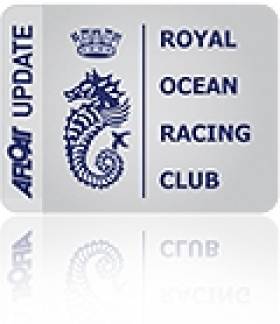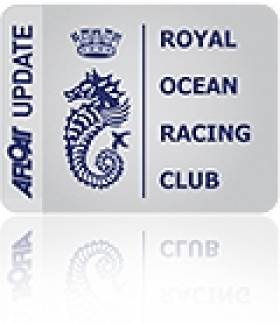Displaying items by tag: MarinersCove.ie
Mariners & Antix Challenge for RORC IRC Gong
Irish Commodores' Cup entrants Marinerscove.ie will head to the Solent next week to defend their RORC IRC title, shadowed by the top-ranking Irish IRC boat this year, Anthony O'Leary's Antix. Blondie IV also takes part under a Hong Kong flag.
The RORC IRC National Championship includes competitors from Belgium, France, Great Britain, Hong Kong, Ireland and the Netherlands. The international fleet contains many of the competitors that will be taking part in this year's Rolex Commodores' Cup and the scene is set for some close racing between rivals old and new. All of the classes racing at the IRC National Championship are brimming with talent.
IRC Super Zero has the mouth-watering prospect of the high performance big boat class lighting up the Solent including some TP 52s; Johnny Vincent's Pace, Charles Dunstone's TEAMORIGIN Rio, the British Keelboat Academy's John Merricks II and Rob Grey's Farr 52, Bob.
IRC Zero is virtually composed of Rolex Commodores' Cup contenders from six different countries. Anthony O'Leary's Ker 39, Antix, is the current Irish IRC Zero National Champion but only just beat Dave Dwyer's Mills 39, Marinerscove.ie, by a single point less than a month ago. However Marinerscove.ie is the reigning IRC National Champion and will not be letting go of the trophy without a struggle.
IRC One has a highly competitive international line-up. Philippe Delaporte's Pen Azen is over from France and the J 122 is a proven winner; having been awarded RORC Yacht of the Year in 2008.
"Pen Azen will be representing France in the Rolex Commodores' Cup this August," explained Philippe. "We see the RORC IRC Nationals as a perfect way to prepare for the event, the crew will be getting used to living in Cowes and the surroundings but also we will get some fantastic racing with our competition on the same race course."
IRC One also includes RORC Commodore, Andrew McIrvine, and Peter Morton's First 40 La Réponse, who will have their first inshore encounter with sister ship Coup De Coeur raced by Marc de Saint Denis and Géry Trentesaux. Other top contenders include Jim Macgregor's Elan 410 Premier Flair, and Robert Davies' brand new Corby 36, Roxy 6. IRC One should also provide some tense moments and close mark roundings with five First 40.7s amongst the high caliber fleet.
IRC Two is the largest fleet competing and includes the biggest variety of designs including David Aisher's J 109, Yeoman of Wight, Wouter Borghijs' A 35, Tontin, from Belgium and Chris and Hannah Neve's First 35, No Chance, who have been selected for the forthcoming Rolex Commodores' Cup. "The First 35 is a new design this year and we are absolutely loving the boat," explained Chris Neve. "We are really looking forward to the championship."
The scratch boat in IRC Three is Mike and Jamie Holmes' J 97, Jika Jika, who should have a close tussle on the water with Richard Sparrow's J 92, Who's To No.
There are several Quarter Tonners expected including Paul Kelsey's Runaway Bus, James Morland's Menace and Louise Morton's Espada. "This week there were 35 boats competing for the Quarter Ton Cup, enjoying some fantastic racing. It would be marvellous to see a big turn out for the RORC IRC National Championship, it is a great event and one not to be missed," said Louise.
Irish Trio Head for UK IRC Championships
The RORC UK IRC National Championship includes a trio of Irish boats that adds spice to an event that alos draws competitors from Belgium, France, Great Britain, Hong Kong and the Netherlands. Competing on tight Solent courses there is no doubt that this will be a very competitive regatta with plenty of high-octane action writes Louay Habib.
The international fleet contains many of the competitors that will be taking part in this year’s Rolex Commodores’ Cup and the scene is set for some close racing between rivals old and new. All of the classes racing at the IRC National Championship are brimming with talent.
IRC Super Zero has the mouth-watering prospect of the high performance big boat class lighting up the Solent including some TP52s; Johnny Vincent’s Pace, Charles Dunstone’s TEAMORIGIN Rio, the British Keelboat Academy’s John Merricks II and Rob Grey’s, Farr 52, Bob.
IRC Zero is virtually composed of Rolex Commodores’ Cup contenders from six different countries. Anthony O’Leary’s Ker 39, Antix, is the current Irish IRC Zero National Champion but only just beat Dave Dwyer’s Mills 39, Marinerscove.ie, by a single point less than a month ago. However Marinerscove.ie is the reigning IRC National Champion and will not be letting go of the trophy without a struggle.
IRC One has a highly competitive international line-up. Philippe Delaporte’s, Pen Azen, is over from France and the J 122 is a proven winner; having been awarded RORC Yacht of the Year in 2008.
“Pen Azen will be representing France in the Rolex Commodores’ Cup this August,” explained Philippe. “We see the RORC IRC Nationals as a perfect way to prepare for the event, the crew will be getting used to living in Cowes and the surroundings but also we will get some fantastic racing with our competition on the same race course.”
IRC One also includes RORC Commodore, Andrew McIrvine, and Peter Morton’s First 40, La Réponse, who will have their first inshore encounter with sister ship Coup De Coeur raced by Marc de Saint Denis and Géry Trentesaux. Other top contenders include Jim Macgregor’s Elan 410, Premier Flair, and Robert Davies’ brand new Corby 36, Roxy 6. IRC One should also provide some tense moments and close mark roundings with five First 40.7s amongst the high caliber fleet.
IRC Two is the largest fleet competing and includes the biggest variety of designs including David Aisher’s J 109, Yeoman of Wight, Wouter Borghijs’ A 35, Tontin, from Belgium and Chris and Hannah Neve’s First 35, No Chance, who have been selected for the forthcoming Rolex Commodores’ Cup. “The First 35 is a new design this year and we are absolutely loving the boat,” explained Chris Neve. “We are really looking forward to the championship.”
The scratch boat in IRC Three is Mike and Jamie Holmes’ J 97, Jika Jika, who should have a close tussle on the water with Richard Sparrow’s J 92, Who’s To No.
There are several Quarter Tonners expected including Paul Kelsey’s Runaway Bus, James Morland’s Menace and Louise Morton’s Espada. “This week there were 35 boats competing for the Quarter Ton Cup, enjoying some fantastic racing. It would be marvellous to see a big turn out for the RORC IRC National Championship, it is a great event and one not to be missed,” said Louise.
Early entry closes tomorrow, Thursday 17th June. For full information go to the RORC web site: http://www.rorc.org






























































